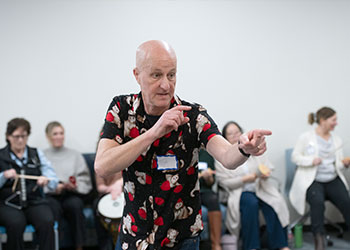Music as medicine
Conga drums thump, tambourines rattle and a trombone moans as Tim Steiner — wearing a black shirt emblazoned with cats and strawberries — conducts an unusual symphony inside the Grunigen Medical Library at UCI Medical Center.
Although most of the 30 musicians are rank amateurs — and eight are recovering from strokes or other ailments — the sound is surprisingly melodic.
It’s the West Coast debut of Strokestra, a decade-old “music medicine” program created by London’s Royal Philharmonic Orchestra to help stroke survivors regain movement, socialize and build confidence.
Collaboration brings joy
“It’s amazing,” says Michelle Wulfestieg, 41, who had her first stroke as a child and another at age 25 that sent her into an eight-day coma and still hampers her mobility.
“This is the first time in a long time that I’ve been encouraged to move my body and exercise with music and not feel self-conscious," says Wulfestieg. "It made me happy and joyful.”
The recent two-hour workshop was a collaboration between the Royal Philharmonic — which ran the session — and the Division of Geriatric Medicine and Gerontology at UCI School of Medicine, led by Dr. Lisa Gibbs. Seven music students from UCI’s Claire Trevor School of the Arts also participated.
Healing the mind and body
UCI Health is considering whether to adopt the rehabilitation program for stroke patients and possibly others.
“I’ve always been interested in the impact of music on health, particularly on brain health and aging,” says Gibbs, who earned a bachelor’s degree in music performance before switching to medicine, inspired by a jazz pianist who became a psychiatrist.
Noting that many studies have shown the benefits of music on the mind and body, Gibbs says she was impressed by the demonstration at the medical library in Orange last month.
It was arranged as part of the London orchestra’s one-week residency with the Philharmonic Society of Orange County, which suggested bringing the Strokestra workshop to UCI Health and helped coordinate the event.
“Patients were engaged and moving in ways they haven’t been in ages,” Gibbs says. “Next we’ll learn how to develop this program at UCI Health to benefit our patients.”
Strokestra's roots
In England, workshop leader Steiner and a few Royal Philharmonic musicians meet and perform with patients, doctors and caregivers several times over a period of months, building toward a public concert.
Between workshops, stroke survivors are given homework assignments.
“When you’re in the kitchen, bang some saucepans to music,” Steiner tells participants.
Rhythmic originality
Each group creates its own groove.
At the UCI Health session, for example, patient Terry Taylor spontaneously began chanting “da da da da” in rhythm with the music and was quickly joined by Royal Philharmonic trombonist Rupert Whitehead and a couple of other musicians.
In turn, that prompted a UCI student cellist and a violinist to twirl their instruments in unison after certain beats.
“This is not a fixed product,” Steiner says. “It’s totally responsive to the people in the room.”
Musical catharsis
Caregivers also praise the results. Cindy Garcia, who accompanied her mother, a stroke survivor, to the UCI Health workshop, wound up playing a cello for the first time — with abandon.
“I believe in living life in technicolor and saying yes to every opportunity,” Garcia says.
The effect was cathartic, she adds: “It’s very stressful managing my mother’s care; I really needed this.”
After setting down his guitar at the end of the performance, Jonathan Gerrard, a doctoral arts student at UCI, says he would gladly volunteer for future Strokestra programs.
“This has been one of the most meaningful musical experiences I’ve ever had.”
Related Stories
- Stroke Rehabilitation Services ›
- Lifestyle changes can prevent stroke ›
- Transforming lifestyle to reduce stroke risk ›
- Royal Philharmonic leads music therapy for stroke patients ›
Explore Further
Browse more blog posts by topic.






